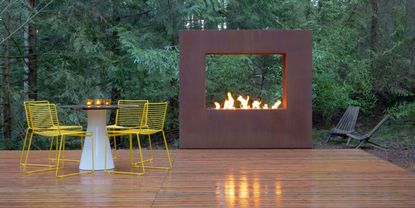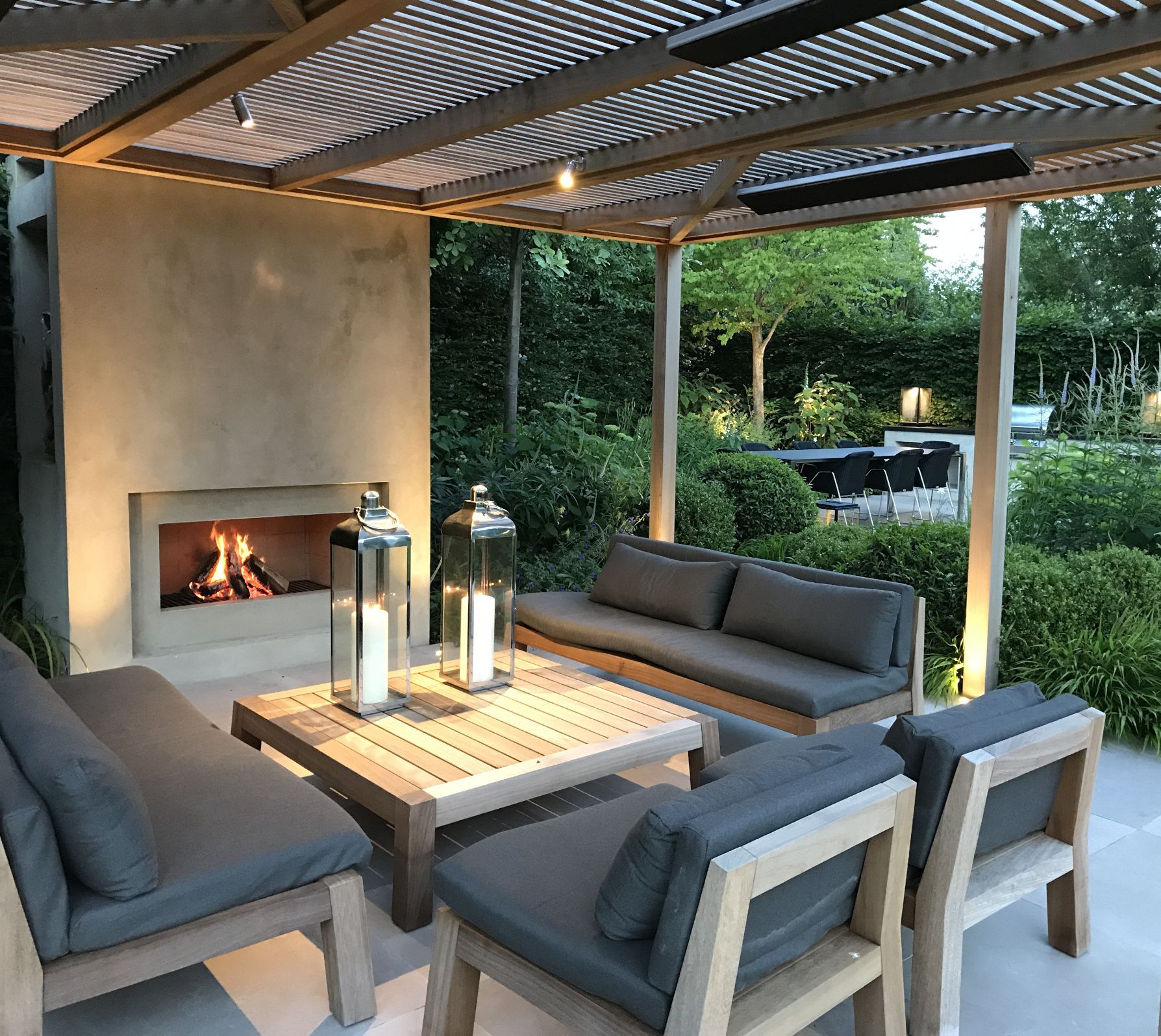Firepit ideas – 10 stylish ways to create a warming focal point in your garden
Firepit ideas come in all shapes and sizes with varying fuel types so it can be tricky making a decision – we've asked the experts to talk us through their top tips


Firepit ideas continue to pique our interest year after year, from solid built-in designs to simpler temporary options. If you're seeking modern garden ideas for your outside space this summer, then a firepit is certainly going to create a talking point.
From graphic gardens with immaculate lawns to relaxed wildflower courtyards, a firepit creates a focal point you can't help but be drawn to as well as a source of heat to unwind by well into the early hours.
There are various options to choose from; be it gas, bio-ethanol, or just back to basics with logs and firelighters, so we've chatted to the experts to help make choosing a new firepit that little bit easier.
10 firepit ideas to extend alfresco evenings
1. Create a built-in fireplace

Firepits are fantastic, but what's even better is a fully integrated and built-in fireplace that creates a real feature of your garden space and helps bring the inside out creating a wonderful indoor/outdoor flow, whether that's winter outdoor space ideas you're after or something for the summer. This white graphic design sits center stage and has a super modern feel while the wild planting softens the whole space.
'The built-in fireplace in this North London courtyard garden acts as the center piece of the courtyard, which when viewed from the house, draws the eye down the garden to the seated area,' says charlotte Rowe, Director at Charlotte Rowe Garden Design. 'A fire can be enjoyed either during the day or at night.'
2. Bio-ethanol vs gas firepits

Are you after garden style tips to get your outdoors ready for a weekend get-together? Lighting, outdoor furniture, and accessories all help create a welcoming space, but a firepit is the real showstopper. The two main types of firepits on the market are gas or bio-ethanol and there are pros and cons to both types, depending on whether you want your firepit just to visually look amazing or if you're after a more practical solution.
'I would suggest the key question to the customer is would you like a fire pit for visual reasons or for practical use?' asks Sam Clifford, Director, A Place in the Garden. 'Bio-ethanol firepits look fantastic but cannot compete with the warmth that a gas firepit can provide. We supply gas fire pits only and this is due to the fact that they are far more effective at keeping you warm.'
'We provide our firepits with either an LPG or mains gas burner. With install for a gas firepit we would always strongly recommend this is installed by a qualified gas engineer,' he adds. 'If clients would like to fit this in a permanent location, we would always advise that the fire pit is thought of from the very beginning of the garden design. This way you can plan to lay the gas pipes to go underground before you lay your new flooring, whether it be decking, tiles or grass.'
3. Transform your garden into an outdoor living room

Outdoor living has surged in popularity since we've been forced to spend more time outdoors the past couple of years and bad weather won't stop us! Create an extra room outside by turning a garden spot into an outdoor living room complete with sofas, coffee table and a built-in attention-grabbing fireplace. Add cover above the seating area to help shelter from the rain or sun.
'This garden in Surrey has a built-in fireplace which provides warmth and ambiance within the covered seating area under the arbor,' says Charlotte Rowe, Director, Charlotte Rowe Garden Design. 'With the lanterns and fire lit, the space becomes a cozy and comfortable area in the garden which can be enjoyed on long summer evenings.'
4. Consider the position of your firepit

There are practical considerations to take into account when planning a firepit in your garden, including how far away the fire should be from the property. Depending on whether it's gas or good old-fashioned flames, you might want to think about the smoke heading back into your home as well as running gas pipes.
'Our gas fire pits have required clearances to combustible materials that must be followed, but these can be as little as 15 cm,' says Khai Foo, Director, Paloform. 'Sit as close as you need to feel the warmth, or farther if you just want to enjoy the view. Gas firepits are low maintenance, but they do require an annual inspection by a gas fitter. This will involve a visual inspection and may involve cleaning.'
'The pros are you have a beautiful centerpiece for your outdoor space that is a natural focal point for social gatherings and relaxation, but the con is that you may spend too much time whiling away the hours, staring at the enchanting flames!' he adds.
5. Plan your firepit into your garden design

It pays to plan your firepit position before you buy it if you can, especially if it's to be a permanent fixture. That way any gas and electrical supplies can be done before your beautiful outdoor space is complete. Consider landscaping trends to make the best use of your space and decide on what firepit might work best for you.
'Our fire pits need to be planned like any other component of an outdoor landscape or patio project. They are solid, permanent installations and require gas and sometimes electrical supplies. This said, most solid-surface materials can be used: concrete, stone, wood or composite decking, etc, says Khai Foo, Director, Paloform. 'Tables and bowls should really be free-standing to display their sculptural designs, but more rectilinear shapes can be built into seating or dining areas.'
6. Smoke vs smokeless

It's important to think about whether you want a wood-burning firepit or not. The real deal creates warmth and a wonderful ambiance but it does mean the not-so-pleasant smell of smoke on your clothes and in your hair. Gas is an alternative, though you have to consider running pipes, and while bio-ethanol designs – which are more environmentally friendly – don't require gas pipes, they also don't give off as much heat.
'There is no denying there is something hypnotic about staring into the embers of a log firepit and the warmth you get from it generally exceeds anything you would get from a gas or bio-ethanol firepit. However they do have some disadvantages to consider – the smoke can be an issue (especially in summer when windows are open),' says Simon Orchard, Garden Designer, Simon Orchard Garden Design. 'Whilst you might not mind smoke blowing into your house, your neighbors might not share the same view. I always suggest to clients that in small gardens, and built-up areas – avoid log firepits, and in larger gardens, site the firepit area away from the house.'
'You also need to consider what you are putting the firepit onto, especially if hot ash is likely to drop onto the ground. So a timber deck or your new sandstone terrace might not be the best thing to stand it on. If you have no other option, place it on a large slab that you don’t mind getting scorch marks on.'
'Gas firepits can be a lot more practical for many people and do not give off smoke. However you need to consider where the gas cylinder would be hidden and how to hide the supply pipe,' he adds. 'If you sit the firepit on decking you can run the supply pipe under the deck and this can easily be retrofitted but taking up a few boards. You can do this with paving obviously, but may not be feasible to retrofit.'
'The third option is bio-ethanol firepits which are becoming increasingly popular. Bioethanol is a liquid fuel with no smell and burns very cleanly with no harmful toxins - much more environmentally friendly, says Simon. 'The fuel container is stored within the firepit unit itself so there are no cylinders or supply pipes to hide. However, the heat emitted is less than a gas or log fire and on some models, you need to wait for the firepit to cool down before refueling.'
7. Choose the right shape for your space

Looking for stylish outdoor heating ideas? Firepits come in a wealth of different styles, from circular and square designs to more offbeat options.
'We have several styles, defined by shape and by function. We have circular and square shapes, meant to be placed at the centre of a radial furniture arrangement and linear designs for longer spaces,' says Khai Foo, Director, Paloform. 'Further, our fire bowls serve more as modern campfires, where we have models with larger top surfaces which may be used as outdoor coffee or even dining tables. Taller styles can be used as space dividers right up to upright outdoor fireplace surrounds.'
8. Opt for firepits with dual use

A firepit that turns into a tabletop when not in use? Yes please! 'We can provide our firepits with tabletops, so they have dual-use,' says Sam Clifford, Director, A Place in the Garden. 'In the day it works as a lovely table and then when you get chilly, you can lift the lid off and get the fire going.'
An elegant outdoor living room has been created on this garden patio with cozy sofas filled with cushions and blankets, lanterns to help light up the area in the evening, plant pots to frame the space and the striking firepit taking centre stage. A space to be enjoyed, winter or summer.
9. Make the firepit a destination within your garden

Sometimes it can be tricky creating a focal point in a garden; somewhere to venture to or somewhere for everyone to gather around – like we do in our living rooms or kitchens. Firepits are the perfect centerpiece in the garden that fills that spot – they're beautiful to look at and are enjoyable to sit around, somewhere to chat away with friends, to enjoy a glass of your favorite drink, or even toast snacks.
'Firepits are a very popular feature currently in gardens. In this garden, the firepit is more for visual effect than to provide massive warmth as it is gas-powered rather than solid fuel. It creates a destination at the end of the garden and is surrounded by planting and trees to give a feeling of a ‘secret garden’,' says Charlotte Rowe, Director, Charlotte Rowe Garden Designs.
10. Permanent or fixed firepit?

Firepits are a great way to keep warm in the evenings all year round and they're a wonderfully atmospheric place to gather around with friends. But do you want a bit more from your firepit? Maybe something that's practical and easy to keep clean or one you can even cook on?
'Firepits can be an almost sculptural focal point, like this cast iron Morsoe firepit, which is both beautiful and functional,' says Catherine Clancy, Garden Designer, Catherine Clancy Garden Design. 'There are lots of different kinds of fire pits, so its really down to personal taste, whether you want a permanent feature (such as the gas fire pits) or one you can pack away in winter or move around the garden. Also, do you want to cook and BBQ on it? If you want a BBQ and a firepit and are short of space, use something that doubles up as a BBQ. One that is portable, can be moved around the garden, but mostly sits where it is.'
'You can use something like a Corten steel barrel firepit with a lid, which keeps it dry so it's easy to light the next time you want to use it,' she adds. 'Plus, if you have a wood firepit, you also need somewhere to store wood… there are lots of really attractive outdoor wood stores available now, including wood store seats.'
What type of firepit is best?

Which firepit is best really comes down to personal preference in terms of aesthetics but also practically. Real wood gives off wonderful heat but also not-so-pleasant fumes. Gas designs are best for a permanent fixture while Bio-ethanol firepits are best for the environment if you're keen on green energy, but they're not as good for warming you up.
'Gas fire pits are a great option if you are in a smoke-free zone or just don't want the hassle of storing logs and cleaning out the ashes from your firepit,' says Catherine Clancy, Garden Designer, Catherine Clancy.
'There are various points to consider when it comes to choosing and installing a fire pit as part of your outdoor living space,' says Duncan Aird, Founder, Outdoor Kitchen Expert. 'First and foremost is how much space you have available. 'Do you prefer a rustic, natural feel or are you after something sleek and contemporary? There are no right or wrong answers here, as there are so many different kinds of fire pits on the market these days that there’s something to suit everyone’s tastes and needs… and to suit different budgets.'
'Some of the most common choices include chimineas, freestanding fire pits, built-in brick (or stone) fire pits and fire pits with grills. You can also get some lovely table top and portable fire pits, which provide plenty of flexibility in terms of moving your outdoor living space around from time to time,' he adds.
'When it comes to installation, calling in the professionals is a great way to enjoy peace of mind and know that your fire pit will be safely constructed and installed. However, if you prefer to install or build your own fire pit, think carefully about positioning. Clear away any overhanging branches and avoid locations close to sheds, fences, trees and shrubbery. You’ll need to consider wind direction too, to avoid blanketing your property (or your neighbours’ properties) in smoke.'
Do firepits actually keep you warm?

Firepits do keep you warm but some work better than others – real wood fires tend to throw off more heat than gas, propane, or bio-ethanol designs. So depending on where you live in the world and how chilly it gets in the evening, it's worth considering the heat output.
'Because most urban fire pits are powered by gas or propane, they don’t give off as much heat as burning wood, however, they provide enough heat to take the chill out of cool spring or autumn evenings,' says Khai Foo, Director, Paloform.
Be The First To Know
The Livingetc newsletter is your shortcut to the now and the next in home design. Subscribe today to receive a stunning free 200-page book of the best homes from around the world.
As the Houses Editor on Livingetc, Rachel has been obsessed with property ever since she was a kid. With a diploma in interior design and more than a decade working on interior magazines under her belt, she feels very at home sourcing the best contemporary houses the world has to offer for Livingetc. It's not just the day job either, she admits she's spent a scary amount of her own time researching schemes for her own renovations - scrolling Instagram, stalking Rightmove and Modern House, flicking through magazines and snooping in other peoples' windows - so she really does live and breathe houses on a daily, if not hourly, basis. Before Livingetc, Rachel had a stint finding homes for Ikea Family magazine where she was lucky enough to gallivant around the world on shoots meeting and interviewing interesting people, all with a very keen eye for blending high-end design with everyday items from Ikea. It inspired her to not be afraid of mixing new and old, expensive and affordable, vintage and modern and so Rachel's current Victorian terrace in north London is very much an updated, contemporary take on a period property; think open-plan modern kitchen with concrete floors, feature fireplaces and her grandmother’s paintings on the walls. Rachel is currently crushing on reeded glass, large gingham prints, squishy curved furniture; like Buchanan Studio’s Studio chair, and vintage wall sconces; she especially adores Retrouvius for sourcing antique finds and feels inspired by Lonika Chande, Beata Heuman and Matilda Goad and already can’t wait to start planning her next home, wherever that might be.
-
 What are the Most Comfortable Pillowcases? From Temperature Regulating to the Best for Your Skin
What are the Most Comfortable Pillowcases? From Temperature Regulating to the Best for Your SkinWhen you're looking for comfort in your pillowcases, material matters. These are the best you can buy
By Faaizah Shah Published
-
 5 Simple, but Genius Bathroom Layout Tricks That Will Make Your Space Work so Much Harder
5 Simple, but Genius Bathroom Layout Tricks That Will Make Your Space Work so Much HarderSmall switches to how you lay out your bathroom that help make the most of a small space
By Luke Arthur Wells Published

